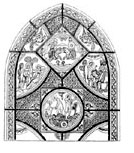
“This Is My Body…My Blood”
THE REAL PRESENCE IS A PHYSICAL PRESENCE
When converts recount their journey to the Catholic Faith, they often say: “There was always something different about being in a Catholic church. God seemed to be present in Catholic churches in a way that He was not in other churches.” These people were drawn to the Catholic Faith by the Real Presence of Christ in the Blessed Sacrament. What a consolation given to the Church by our Savior! We have Jesus Christ dwelling among us in the flesh, yet few Catholics adequately understand this mystery and miracle.
The difficulty today is that Catholics are being influenced by some Catholic educators who have drifted toward a Protestant sense of the Eucharist. These educators describe the Eucharist solely as a powerful symbol or as a subjective moment when the communicant becomes united to Christ during the act of receiving the Eucharist. While these perspectives have their merits, the Catholic Church’s teaching on the Real Presence of Christ in the Eucharist is far deeper and richer. Pope Paul VI teaches in No. 46 of his 1965 encyclical, Mysterium Fidei, that after the consecration at Mass, “Christ is present whole and entire in His physical ‘reality’ corporeally present…” (italics added). So when the priest pronounces the words of consecration over the bread and wine during the Eucharist, the bread and wine are physically changed into Jesus Christ, including His physical Body and Blood.
Contrary to this, a number of Catholic educators today reject the belief that the bread and wine are physically changed into Jesus Christ during the Mass. One good example of this is found in Catholic University Prof. Msgr. Kevin Irwin’s article on the Eucharist published in Origins (May 31, 2001). Msgr. Irwin says the following about the Council of Trent’s teaching on Transubstantiation and the Eucharist:
While Trent affirmed (and subsequent magisterial documents have repeated and adapted it) that Christ is present “truly, really and substantially” (Enchiridion Symbolorum, Denz.-Schon., 1651) and that “the whole substance of bread and wine is changed into Christ’s body and blood” (ibid.), nowhere does it state or imply that this change is “physical.”
You May Also Enjoy
In these times, the idea of self-giving love is squeezed out by the identification of love with sexual attraction and pleasure.
He dissents from a basic moral principle of Judeo-Christian, Catholic social teaching: that superfluous wealth must be shared with the poor.
French author Yves Chiron presents Paul as torn between mind and heart, with strong emotional reactions tempered at times by rational thought.

